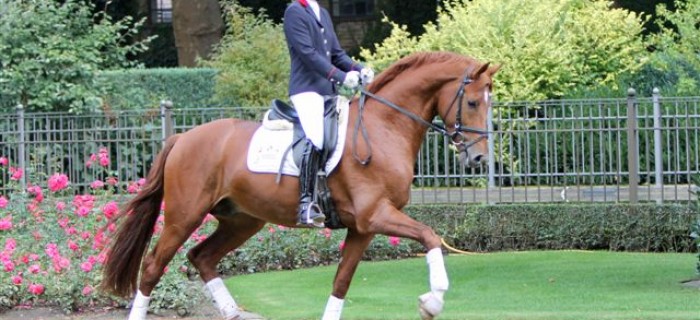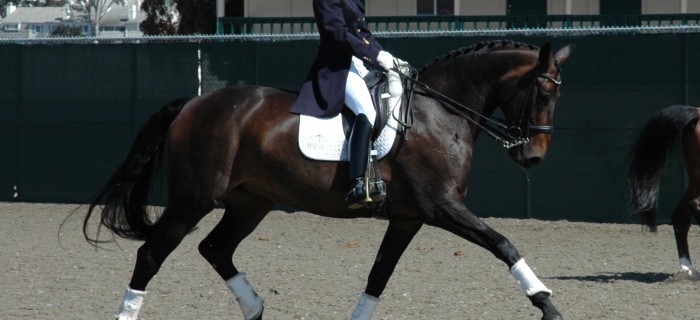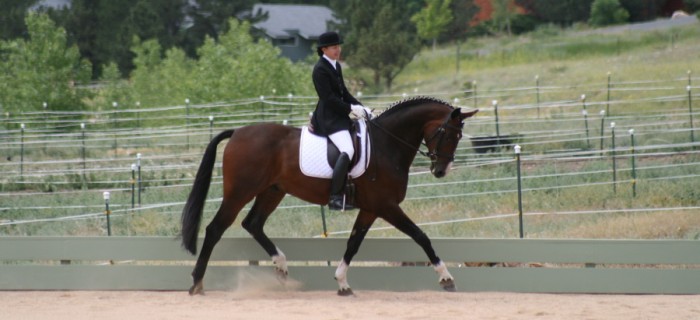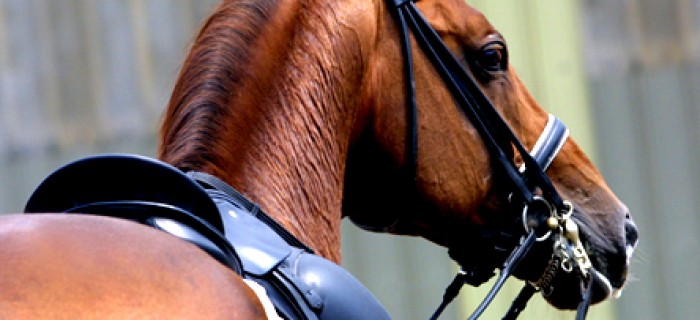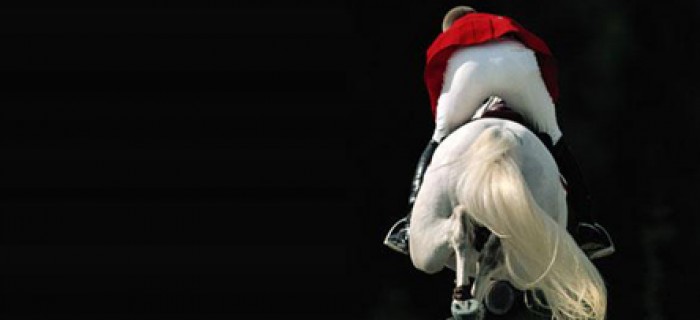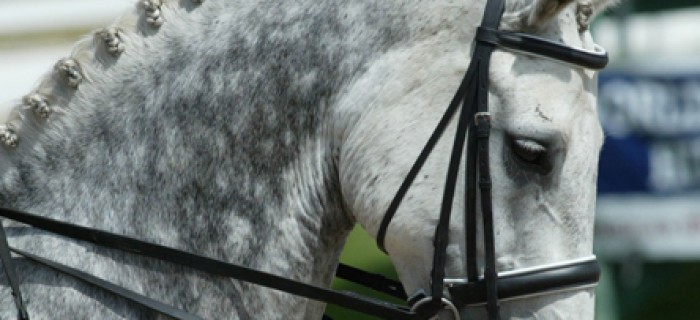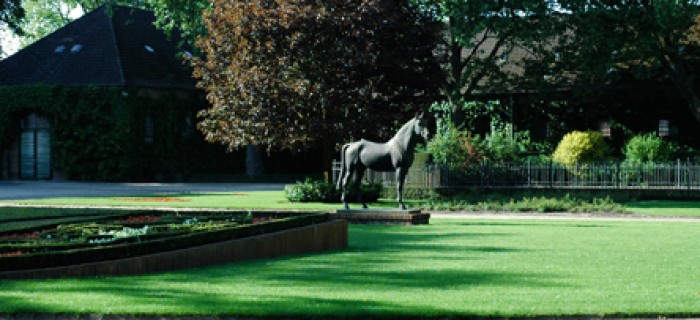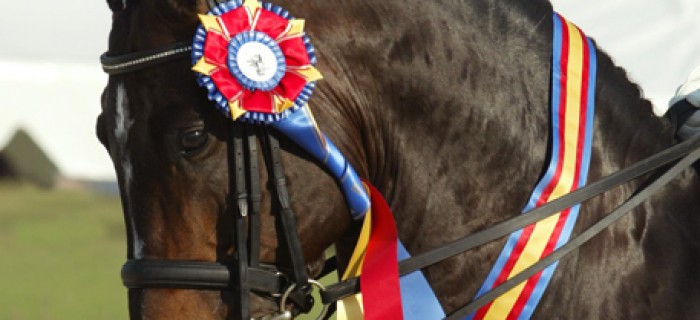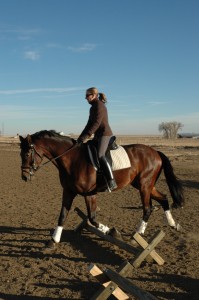 Introduction
Introduction
After having trained your horse on straight lines (see our article of January, Cavaletti Work Part I) it is now time to show your horse the benefits of training with cavaletti on circle lines.
Why cavaletti work on circle lines?
As already discussed in Part I, cavaletti work is a wonderful way to help your horse to build muscles and to find balance. Cavaletti work gives your horses the opportunity to activate his hind leg and helps him to relax his neck and back by arching the back upwards and bending his neck seeking the bit in a forward-downward manner. But it is a challenge for the horse to find his balance while working with cavaletti and this challenge will increase by adding the bending of the longitudinal axis, the way we ask him to do on a circle line.
Cavaletti work on circle lines will enable your horse to
- to activate his hindleg
- to build up muscle in the correct way
- find balance
- improve your horse’s ability to bend on the longitudinal axis. This will improve his balance and will be a good preparation for the coming exercises like pirouettes, half passes and every movement of the advanced dressage that requires a good bending of the longitudinal axis.
Working your horse with cavaletti on the circle lines is as much fun as working him on the straight lines and it brings your horse the much needed variety in his daily work. The increasing physical strength will give your horse the ability to concentrate better and work with you the way he wants to giving his best to please you.
Let’s get started on the circle line!
Are you curious enough by now? So let’s start with our lesson! Working on a circle line is a bit more difficult for the horse because he has to balance himself on a circle. So be sure to have practised cavaletti work on the straight line with rider or on a circle line without rider to get your horse acquainted with this kind of work before starting cavaletti work with rider on a circle line.
Do not forget:
Security advices
- Start your cavaletti work with a thorough warm up. Both horse and rider should be working for about 20 min before starting cavaletti work.
- Be sure to protect your horse’s legs with bandages, sport boots, and bell boots.
- Shorten your stirrups two or three holes.
- Stabilise the poles you are using. The poles should never lie on the ground without some sort of block securing them. If your horse steps accidentally on them he can hurt its fetlock badly. You can use the fabricated cavaletti blocks or even a short plank mounted under the poles will prevent that they roll.
- Do not use cavaletti of the type with a little cross while lungeing. The lunge can get caught in the cross and tear the cavaletti behind the horse thus causing your horse a lot of stress.
- Be sure to have the correct distances for your horse’s stride. When working in a group be sure to have a helper on the ground who adjusts the cavaletti for each horse.
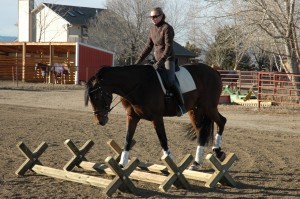 Today we will start or circle line training with a bit of medium walk over cavaletti. It is better to start again with one or two poles adding a third and fourth if your horse is comfortable, even if you have already worked with cavaletti. We can add the third and fourth pole very quickly but it is better to proceed in small steps before causing a lot of stress for the horse. Remember again: you and your horse should have fun while working together. Do not try to put too much into today’s work. Tackle the cavalleti work on the circle line again in two or three days and you will see how much your horse has learned in a short period of time
Today we will start or circle line training with a bit of medium walk over cavaletti. It is better to start again with one or two poles adding a third and fourth if your horse is comfortable, even if you have already worked with cavaletti. We can add the third and fourth pole very quickly but it is better to proceed in small steps before causing a lot of stress for the horse. Remember again: you and your horse should have fun while working together. Do not try to put too much into today’s work. Tackle the cavalleti work on the circle line again in two or three days and you will see how much your horse has learned in a short period of time
The poles are put onto the circle line into a row with a distance of 80 cm (2.6 feet) up to 100 cm (3.3 feet) in between. The big advantage of working with cavaletti on the circle line is that you can put the poles in a way that enables you to give them a distance of 80 cm on the inner side of the circle and up to 100 cm on the outside of the circle. Riding over the cavaletti on the inner side of the circle will shorten the stride of the horse while riding on the outside will lengthen the stride. This way you can add variety with one position of the cavaletti without having to change the distance from the ground. It makes working in a group a bit easier as well, because you can ask your riders to ride over the cavaletti depending on the stride of their horses without having to change the position of the cavaletti for each horse. Start with long reins and let your horse look at the cavaletti . Then ride over the cavalleti every second round. Ride on a steady circle line before, over, and after the cavaletti while controlling you horse’s hindleg with the outside leg and keeping contact with both reins. Try to build up a steady rhythm before riding over the cavaletti and preserve this rhythm over and after the cavaletti. It helps many riders to count the rhythm over the cavaletti and to keep counting after them. You can add work in trot or canter on your rounds you are not riding over the cavaletti. Then half halt your horse back to the walk, stabilise the rhythm and the circle line, and let your horse walk over the cavaletti. Then trot or canter again but come back to the cavaletti in walk. It will be amazing to see what happens with your horse after a few rounds of this exercise. Your horse will start to relax and seek the bit.
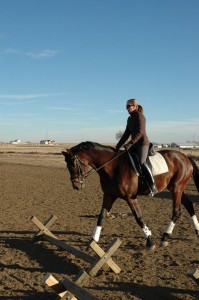 If your horse is comfortable with the cavaletti work in walk we can start to work in trot. Remember: always start with one or two poles at a time. Just because your horse does the cavaletti work in the walk, does not mean that he can muster up the balance and concentration to do four cavaletti in trot from the beginning.
If your horse is comfortable with the cavaletti work in walk we can start to work in trot. Remember: always start with one or two poles at a time. Just because your horse does the cavaletti work in the walk, does not mean that he can muster up the balance and concentration to do four cavaletti in trot from the beginning.
The distance for the placement of the cavalletti in the trot is 1.20 (3.9 feet) to 1.40 m (4.5 feet) depending on your horse’s stride and your goals. On the circle line you can put the poles on a distance of 1.20 m on the inner side and 1.40 m on the outside of the circle. If we want to strengthen the rhythm a distance of 1.20 m will be ok. While starting your work in trot chose the distance that your horse is comfortable with and try to shorten or lengthen the strides by trotting over the cavaletti on the inner or the outside of the circle. The procedure is the same as in walk: you trot every second round over the cavaletti, build up a clear circle line and a steady rhythm before, over and after the cavaletti. You can ad canter or walk work on your “cavaletti-free” rounds, then half halt to trot and trot over the cavaletti again. Integrate your cavaletti work into your dressage work, offering your horse every now and then one round over the cavaletti and then returning to your work you were doing before.
If you think that you horse still has the strength to do the cavalletti in canter, put the poles in a distance of 3 to 3.5 m. Start with one cavaletti and find a rhythm in the canter before cantering over the cavaletti. Do not change this rhythm when starting your work over the cavaletti. Be aware that many horse jump the first time they try to do cavaletti work in canter. Try to keep a seat over the cavaletti, keeping steady contact with the reins. After a while, you can add more cavalettis and thus work on a steady rhythm.
Upcoming problems
A very common problem doing this kind of work is that your horse gets excited and tries to overachieve. In this case, diminish the challenge by taking out one or two poles thus, coming back to basic work until your horse is able to relax again.
While working your horse in canter be sure not to add a second or third pole before your horse is totally comfortable. He shouldn’t make big jumps over the cavaletti but activate his hind leg thoroughly. Keep you seat over the cavaletti and a steady contact with both reins.
While trying to heighten the cavaletti try first to heighten one cavaletti in the row, for example the last one. If he keeps his rhythm you can heighten a second one, for example the second one. Be sure to offer him a row of poles in the right distance thus showing him that nothing has changed except one height of one cavaletti. This will prevent him from jumping over the cavaletti and losing his rhythm.
General recommendation
Work on both leads. Do not bore or tire your horse with working too long over the same distances. Remember that cavaletti work is very strenuous for your horse. The cavaletti work itself shouldn’t exceed 30 min. Finish your training when your horse does the best. Do not forget to let your horse relax after this work by walking with him for a while and to tell him that he did great.
Enjoy riding!
Share

